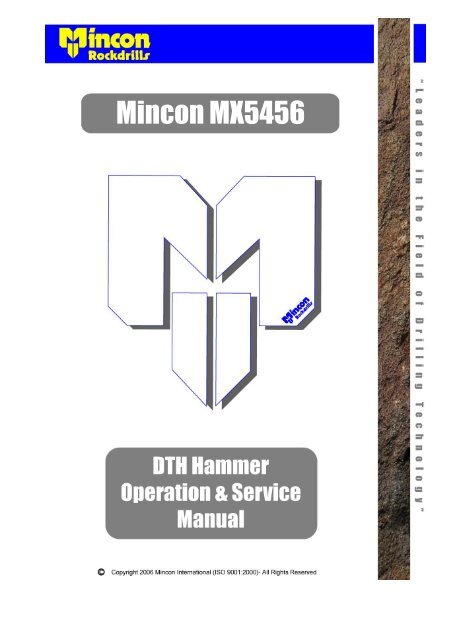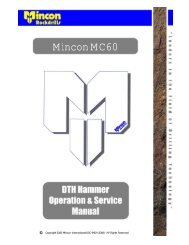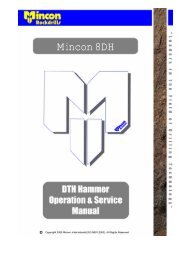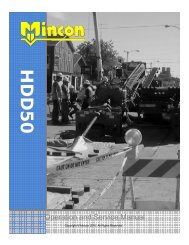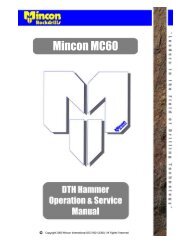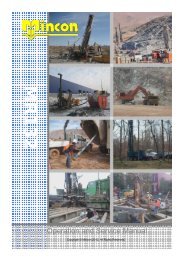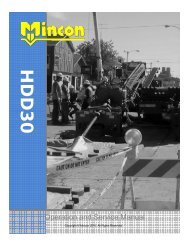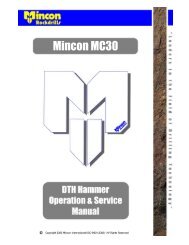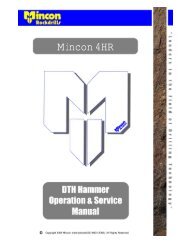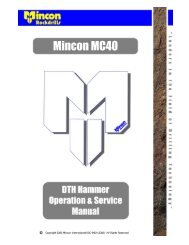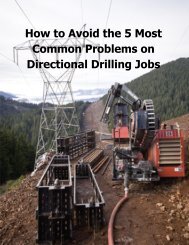Mincon MX5456
Mincon MX5456
Mincon MX5456
Create successful ePaper yourself
Turn your PDF publications into a flip-book with our unique Google optimized e-Paper software.
<strong>Mincon</strong> <strong>MX5456</strong>
Table of Contents1. INTRODUCTION ........................................................................................................................... 32. INSTALLATION AND OPERATION .............................................................................................. 32.1 SAFETY ........................................................................................................................................................... 32.2 HAMMER CARE. ............................................................................................................................................... 32.2.1 Storage .................................................................................................................................................... 32.2.2 Commissioning........................................................................................................................................ 32.2.3 Lubrication ............................................................................................................................................... 42.2.4 Operation ................................................................................................................................................ 42.3 SERVICING ...................................................................................................................................................... 52.3.1 General ................................................................................................................................................... 52.3.2 Opening Chuck and Backhead ............................................................................................................... 52.3.3 Dismantling Hammer to Change Drill Bit ................................................................................................ 52.3.4 Disassembly for Full Servicing of Hammer ............................................................................................. 52.3.5 Inspection ................................................................................................................................................ 62.3.6 Checking Wear Limits ............................................................................................................................. 62.3.7 Reassembly ............................................................................................................................................ 63. TROUBLE SHOOTING ................................................................................................................. 84. APPENDIX .................................................................................................................................... 94.1 REVERSE CIRCULATION HAMMER EXPLODED VIEW AND PARTS LIST AND TECHNICAL DATA ................................ 94.2 HAMMER SERVICE LOG .................................................................................................................................. 105. WARRANTY ............................................................................................................................... 11<strong>Mincon</strong> Rockdrills – “The Driller’s Choice” Page 2
1. IntroductionThank you for choosing the <strong>Mincon</strong> <strong>MX5456</strong> reverse circulation hammer. Please read this manual carefully before using yourhammer in the interests of safety, warranty and best operational care. The <strong>Mincon</strong> <strong>MX5456</strong> is manufactured with speciallyselected materials and heat treatment to withstand the stresses of drilling in the most extreme conditions. Internal componentsare manufactured to meet finely matching tolerances to provide fast drilling, reliability and efficient use of air without waste.With correct care your <strong>Mincon</strong> <strong>MX5456</strong> hammer should provide you with top performance reliability and long service life.Warranty is provided by <strong>Mincon</strong> as per the warranty section 5.Please keep this instruction manual as a permanent record for your reverse circulation hammer.The specifications and instructions contained in this manual are based on the up-to-date information as at publication date.2. Installation and Operation2.1 SafetyBe sure to work safely at all times. Wear protective clothing and safety equipment and observe all safety regulations asprescribed by your employer, Government, or the site on which you work. Do not wear loose clothing that may get caught inrotating parts and cause serious personal injury.Remember that a “Reverse Circulation” percussive hammer emits noise and you should therefore take every precaution tosafeguard your hearing against damage by using proper ear protectors. Use eye protection at all times. Rock chips and dustwhich may be discharged from the face of the bit or bore hole at high velocities and can cause severe injury.Hammers can be heavy – Always use proper and approved lifting equipment and take every precaution to safeguard yourselfagainst injury. Keep hands clear at all times – Beware of getting fingers trapped between the chuck and bit and do not usehands or feet to clear the top of the borehole at any time.Other safety advice is given throughout this document which you are advised to read.2.2 Hammer Care.2.2.1 StorageIt is important to take the following steps in order to ensure smooth operation when hammer is to be re used.When the hole is completed and the hammer is to be inactive for some time the following steps should be taken.Short Term Storage (e.g. 1 -2 weeks)Using high pressure air, blow the hammer clear of all water.Turn automatic oiler up full and cycle hammer until oil is running out the shank of the drill bit.If there is not an automatic oiler, pour 1 litre (2 pints) of rock drill oil in to the back head/Top sub.Turn the air on and cycle for 10 seconds. This will lubricate the internal parts.Seal the hammer at the back head (top sub) and chuck (drive sub) end with a rag to exclude any dust or foreignparticles.Store the hammer horizontally in a clean dry environment.Long Term storage (e.g. 1 month or longer)Using high pressure air, blow the hammer clear of all water.Break out the back head and chuck on the rig as it is easier to do it here than back in the workshop.Disassemble the hammer.Inspect and clean all hammer components.Lubricate all the internal components with rock drill oil.Reassemble the hammer, and seal the back head and chuck end.Store horizontally in a clean and dry environment.Before restarting any hammer after prolonged periods of inactivity, disassemble and inspect all internal parts. Clean andremove any oxidation with an emery cloth. Re-lubricate all internal components with rock drill oil and reassemble the hammer.Full assembly and disassembly instructions can be found further on in this manual.2.2.2 CommissioningAlways use drill bits in good condition (sharpened). Using overrun bits can affect the life of the bit, chuck/chuck sleeve andreduce penetration rates which can damage internal components due to the non transference of energy in to the rock beingdrilled.<strong>Mincon</strong> Rockdrills – “The Driller’s Choice” Page 3
Air Volume - CFMAir Volume – M 3 /MINAmbient Temperature ºFAmbient Temperature ºCWhen starting a hammer for the first time, or a hammer that has been stored for a prolonged period, please follow the followinginstructions.Grease the threads on the back head and chuck and fit to the hammer complete with drill bit.With the bit in the breakout pot, torque up the hammer until the standoff between the backhead and wear sleeve hasclosed up.Before adding the first drill rod pour 1 litre(2 pints) of rock drill oil in to the back head.Ensure all drill rods are blown clean of any dirt and debris and that all threads are cleaned, greased and all o rings arein good condition before coupling together.Turn on air and blow until oil starts to run out of the bit shank.Cycle the hammer on half air for the first few minutes to run in internal parts.2.2.3 LubricationIt is vital for DTH hammers to receive a constant supply of proper rock drill oil in to the air stream, to lubricate and protect theinternal components, and to provide a good air seal between the piston and its matching component parts for efficient drilling. Itis recommended that an automatic oiling system be used when operating your hammer. Too much oil can cause hydrauliclocking in the hammer. Drilling with insufficient lubrication will cause the hammer to run dry and cause premature wear orfailure. The correct consumption of oil/oil type is dependent upon the air volume and ambient conditions. Please refer to thelubrication graph below for recommendations. There should be visual evidence of oil around the drill bit shank and within thetube joints when changing tubes.The recommended grade of oil is dependent on the ambient temperature in which drilling is taking place as well as theoperating pressure. As a rule of thumb, ISO320 grade rock drill oil should be used whenever possible as the hammer is a highfrequency tool, however, where the pump cannot pump the oil in colder conditions, a lower viscosity of oil can be used as perthe graph below.Remember: Insufficient lubrication or incorrect lubrication grades may result in damage being caused to the hammerand its components. Hydraulic oils, engine oils, gear oils and diesel are not recommended for lubricating DTH reversecirculation hammers.Litres/HourPressure - Bar1500125010007505002501 2 3 4 52 4 6 8 10US Pints/Hour42.035.028.021.014.07.06.9 13.8 20.7 27.6 34.5120 48.920ISO150-6.70-17.8ISO40-20 06-28.9100 200 300 400 500Pressure - PSIAt low temperatures of 5ºC (41ºF), and in hot humid conditions with higher air pressures, when hammers can freeze up. Antifreezeadditive may be required at a rate of 1-2 litres (2-4 pints) per hour or more as necessary.2.2.4 OperationBe sure to familiarise yourself with the controls of the rig and work in accordance with the rig manufacturers recommendations.The hammer begins to operate as the air supply is turned on and when the drill bit is pushed firmly into the hammer. Excessivethrust pressures are not needed to make the piston cycle. The thrust controls on the drill should be adjusted to the correctpressure and should be readjusted to take account of the weight of any extra drill rods added, so that the thrust pressureremains constant and not excessive. Insufficient thrust pressure will make the hammer drill erratically and less efficiently andcause premature wear to the bit and chuck splines with likely damage to the hammer components and threads.When the hammer is lifted from the rock face, the drill bit extends from the chuck and the percussive action ceases. The air willpass through the hammer, which can be used to flush the hole clean.Rotation speeds should be selected to suit drilling conditions and drill bit diameters. High rotation speeds can cause prematurewear of drill bits, hammers and drill rods. Too slow a rotation speed can cause binding in the borehole and damage to drill bitinserts through the snatching rotation action.In hard and soft formations of rock, the aim of the hammer is to penetrate smoothly at the rate of 10mm (0.375”) per drill rodrevolution. Generally in softer geology, higher rotational speeds can give better results.The controls of the drill should be adjusted in order to provide the largest drill chip size with the smoothest rotation and feedcharacteristics. Rotation speeds should be set to suit the rock conditions being drilled.100806040ISO32000037.826.715.64.4<strong>Mincon</strong> Rockdrills – “The Driller’s Choice” Page 4
Some ground conditions may cause binding within the hole, with the added risk of the hammer, drill bit and drill string becomingjammed. Any excessive pullback forces or high rotation speeds used in an attempt to recover the drill string may generate heatzones around the hammer, which may affect the metallurgy of the components to cause damage and ultimate premature failure.A backreamer sub may help reduce jamming in bad ground conditions and prevent heat damage.It is recommended that you do not pour diesel into the hammer if it becomes bogged. However if this is done, there is the riskan internal combustive effect if the hammer is fired while there is diesel in it. This will damage the hammer and its components.Any heat induced failures are not covered by our terms of warranty.Before adding drill rods make sure that the threads are clean, well greased and all O rings are in good condition. Ensure thatthere are no contaminants likely to enter the hammer to cause damage and early wear.It is recommended that proper drill guides and break out systems be used which suit the diameter of the hammer. All tools andspanners used for the drill bit and break out flats should fit properly.Make certain that the hammer is stationary when applying spanner or breakout tools. Do not rotate the hammer with a spannerattached to the drill string unless it is safely captivated within the breakout clamp.All internal hammer O Rings, check valve and check valve seal should be examined and replaced periodically, to ensureoptimum performance and effective sealing from borehole ingress.2.3 Servicing2.3.1 GeneralDismantling the Hammer for servicing or to change the bit can be made easier if the chuck threads are regularly greased andthe backhead threads are well greased any time the hammer is opened for servicing. We recommend that a good qualitythread grease be used, and in acidic conditions, we do not recommend copper based greases as this can trigger a galvanicreaction with corrosive effect to damage the root of the threads and cause failure.2.3.2 Opening Chuck and BackheadTo open <strong>Mincon</strong> DTH hammers please adhere to the following instructions.The threads used in <strong>Mincon</strong> hammers are right hand threads. Therefore they loosen in an anti clockwise direction.Please use a bit breakout pot to hold the drill bit when opening the chuck.Please ensure that the wrench is not placed on the threaded section, or the piston running area of the wear sleeve.Break out wrench jaws should be in good condition. It is good practice to keep a spare set of jaws with the rig.Do not strike or hit the outer components as this could weaken the heat treated steels, and distort accurate runningdiameters.Hitting the hammer may also cause hard metal fragments to be chipped off which may be projected and causepersonal injury or eyesight loss.Do not apply heat to the hammer, as this can alter the metallurgical composition and result in premature failure.Take care when dismantling the hammer to make sure that parts and drill bits do not become detached and causedamage or personal injury.2.3.3 Dismantling Hammer to Change Drill BitWhen changing the drill bit please follow this procedure.Please follow the opening instructions from section 2.3.2.For external flush model hammers, lift the chuck sleeve over the threads of the chuck.Lift the chuck up along the shank of the bit to push the retaining pins out from the chuck.Inspect the splines and threads of the chuck for damage, excessive wear or galling.Inspect the sample tube end wear. Be careful checking sample tube wear as the end can be extremely sharp. Alwayschange the sample tube before it is worn out.Inspect the face of the piston for any pitting or cracking on the strike face. If there is any damage then it should bereplaced. Please do not inspect the piston while it is suspended on the drill rig. Always do this with the hammer in ahorizontal position. If the piston nose is damaged it is likely that the Aligner/Bearing bush is damaged as well.Inspect the Aligner/Bearing bush for any damage. If there is any damage then it should be replaced.Grease the threads on the chuck and place the chuck down over the splines of the bit.Insert retaining pins in to place within the chuck/drive sub, with the flat side facing outwards.In the case of external flush hammers place the Chuck sleeve on to the chuck encapsulating the retaining pins.Screw the chuck bit assembly in by hand to ensure that the sample tube does not get jammed up in the bit when fullyshouldered up.Torque up the hammer with the bit in a bit break out pot to ensure it does not run loose.2.3.4 Disassembly for Full Servicing of HammerFor full disassembly please follow these instructions.Where possible carry out disassembly in a clean work shop environment.Break out the back head and chuck as described previously.Mark the ends of the wear sleeve as chuck and back head end.Secure the hammer in a chain vice to hold steady.Remove the check valve and spring from the top of the Sample tube.<strong>Mincon</strong> Rockdrills – “The Driller’s Choice” Page 5
At the chuck end of the hammer, push the sample tube end in to the hammer with a piece of wood. Be careful as thisend can be very sharp from wear.From the opposite end pull the sample tube out of the hammer.Remove the steel make up ring, lock ring and spacer from the sample tube.From the chuck end, insert a soft steel drift in to the hammer against the piston strike face.Carefully knock the piston out the backhead end of the hammer. This will push the Inner cylinder/sample tube mountassembly out of the hammer as well. Do not use the sample tube for this process as it would damage it.To remove the Aligner bearing bush, reverse the direction of the piston (the strike face towards the backhead end) andwith the soft steel drift against the piston strike face, carefully knock the Aligner out the chuck end of the hammer.Push the piston out of the back head end of the hammer.As the wear sleeve for MX series RC hammers are not reversible, it is not necessary to remove the piston retainingring. However, if required, please do as follows.Insert a long flat head screw driver in to the groove in the piston retaining ring and lever the ring clear from the wearsleeve groove. Using a hook, pull the ring out of the wear sleeve.The back head is disassembled as so: remove the circlip from its groove and lift the adaptor tube out with the screenassembled around it.2.3.5 InspectionPrior to inspection, thoroughly clean all parts using a suitable cleaning agent. Diesel is not recommended for cleaning as it cancause corrosion to components, and damage to health.All parts should be visually inspected for any signs of damage, wear or cracking. The inner cylinder, wear sleeve and lock ringscan be checked for unseen cracking by suspending them and lightly tapping with a screw driver. If they emit a ringing tone thenthey should be sound. However, a dull flat tone if emitted may indicate cracking, and the part should be replaced.Take particular care to check the internal bore of the wearsleeve for pick-up marks and galling. If these are present, the barrelof the wear sleeve should be honed out, using a hand hone to remove them. It is usual that if there are signs of damage or heatchecking on one part that there is also the same on mating parts.Inspect surface of the piston for pick-up marks and galling (usually caused through poor lubrication or the presence ofcontaminants) and smooth out with emery paper, making sure to clean thoroughly afterwards. Where galling of the piston hasoccurred, substantial heat has been generated and quite often, micro cracking has occurred on the piston. In these cases, thepiston should be replaced if there is evidence of such cracking. Check the strike face of the piston for cracking or damage.Inspect the Aligner for any galling or cracks. If either is present, then the aligner should be replaced.All internal hammer O rings, check valve and check valve seal should be examined and replaced periodically, to ensureoptimum performance and effective sealing from borehole ingress.2.3.6 Checking Wear LimitsThe performance of the hammer is dependent on the designed running clearances of critical components. These should bemeasured and recorded in the Service log in the appendix. The service log gives the location of where measurements shouldbe made. Depending on how many parts need to be replaced to bring the hammer back to optimum performance, it may beeconomical to replace the hammer all together.2.3.7 ReassemblyThe hammer can be reassembled in the following manner, referring to the exploded view of the hammer in the appendix.Ensure all components, except for the sample tube, are liberally coated with good quality rock drill oil and threads with threadgrease. Replace all O rings and check valve seal before re assembly.Identify the chuck end of the hammer and stand with the chuck end facing up. Insert the piston retaining ring in to thegroove provided. Ensure the extraction groove on the retaining ring is facing the chuck end of the hammer.Insert the Aligner (with the smaller outside diameter facing the piston retaining ring) in to the wear sleeve. Using a softsteel drift, tap the aligner in to place against the piston retaining ring.Screw the chuck (and chuck sleeve on external flush models) in to the wear sleeve.Seal up the chuck end of the hammer.Turn the hammer over so the back head end is facing up.Insert the Piston in to the wear sleeve (refer to the exploded view for orientation).Insert the Sample tube mount in to the inner cylinder and fit the seating rings around the round holes on the innercylinder.Insert the Inner cylinder assembly in to the wear sleeve. Tap the assembly in to place using a soft steel drift.Fit the spacer on to the sample tube with the flat face facing down to the drill bit end of the sample tube. Place the lockring on top of the spacer. Place the steel make up ring on top of the lock ring. Place the check valve spring on to thelocating recess on the spacer and fit the check valve in to place.Spray the area under the rings of the sample tube with penetrating oil (e.g. CRC / WD40). If hammer oil is used thenthe sample tube will not go in to place properly because a hydraulic lock will occur between the sample tube shoulderand the sample tube mount.Insert the sample tube assembly in to the hammer.<strong>Mincon</strong> Rockdrills – “The Driller’s Choice” Page 6
Pour hammer oil in to the hammer.Fit the screen to the adaptor tube and insert the assembly in to the back head. Insert the circlip in to the back head tolock the assembly in to place.Screw the back head assembly in to the wear sleeve. There should be a standoff gap of between 0.5mm - 1mm(0.020” – 0.040”) between the back head and wear sleeve shoulders. If the shoulders meet up then the lock ring needsto be replaced so that all internal parts are properly locked in place. Seal up the top of the hammer.Store the hammer on its side and rotate it periodically if it is being stored for an extended period of time.If a hammer is to be stored for a long period of time, we would recommend that the hammer be disassembled, oiledup, and stored in a clean, dry environment.<strong>Mincon</strong> Rockdrills – “The Driller’s Choice” Page 7
3. Trouble ShootingProblem Possible cause RemedyLow penetrationand high pressureRough or erraticoperationLow penetration /Low pressureSudden loss ofpressureExternal drill clearances are worn.Contamination in hammerToo much feed pressureChange or re-sharpen the drill bit. Make sure that the runningclearance on the bit seal is what you need for the drillingconditions.Open hammer and clean the obstructionSet the feed pressure until the rotation starts to bind. Then backoff the feed pressure until the rotation runs smoothlyRotation speed too slow Drill bit peripheral rotation speed of 12 – 15” per second (300-380mm). Place chalk mark on drill rod and check the advancerevolution. If greater than ½” (12mm) per revolution increaserotation until the advance per revolution is a maximum ofbetween 3/8” – ½” (10-12mm)Worn drill clearancesLack of oilOver run/ blown out sample tube.Problem Possible cause RemedyCracked wearsleeve/ externalpart distortion.Piston crackedthrough largediameterPiston strike endbreakingAbuse of wearsleeveWorn wearsleeveCorrosionBogged Drill can lead to reamingand overheating distortion of thedrill.Drill bogged can lead to chuck,wear sleeve and chuck sleeve todistort.Lack of lubrication causes microcracksleading to breakageFeeding hard through voids onbroken ground can causewearsleeve to distort causing heatcracks and galling on the pistonUsing wrench over wrong area toopen drill can cause the wearsleeve to distort.Insufficient down-forceOver running sample tubes willallow ingress between the twostriking faces and cause pistonnose to crack.Inspect piston, inner cylinder, wearsleeve and bearing againstdiscard measurements, and discard as necessaryEnsure there is an oil film coming from bit spline and bit parts.(Place cardboard under bit to check)Check sample tube wear regularly, and change before it is wornout.PART FAILUREAvoid welding, heating or torque wrenching in the wrong placeas outlined in section 1.4. Note also section 1.6Outside diameter has worn beyond the discard point. Measurecasing O/D approx. 75mm (3”) from chuck end and backheadend and replace if necessary.If drilling in a corrosive environment wash internal and externalparts regularly to avoid corrosive impact on the drill.If such danger is imminent use a dig out sub.Inspect all parts thoroughly if drill is recovered, and replaceparts where necessary.Check lubricator and ensure oil film on the bit splines.Use light feed and ensure the hole is kept clean andconsolidated. Use foam or mud if necessaryUse wrench only in theArea indicated.Increase feed until rotation binds and pressure pulses and thenback off until the rotation and pressure becomes smoothReplace sample tubes before they are worn out.<strong>Mincon</strong> Rockdrills – “The Driller’s Choice” Page 8
4. Appendix4.1 Reverse Circulation Hammer exploded view and Parts List and Technical Data12345678910111213141516171819202122232425262728MINCON <strong>MX5456</strong> PARTS LIST AND SPECIFICATIONSItem Description Part Number<strong>Mincon</strong> <strong>MX5456</strong> – 4 ½” Remet Ext Flush<strong>Mincon</strong> <strong>MX5456</strong> – 4 ½” Remet<strong>MX5456</strong>AA01<strong>MX5456</strong>AS011 Internal Circlip 1300-08502 O Ring BS-2283 Adaptor Tube (4 ½” Remet) <strong>MX5456</strong>AT014 O Ring BS-2265 O Ring BS-0416 Air Screen <strong>MX5456</strong>SC017 Backhead (4 ½” Remet) <strong>MX5456</strong>BH018 Check Valve Seal (Nitrile U Seal) 8406-175-N89 Check Valve <strong>MX5456</strong>CV0110 Check Valve Spring <strong>MX5456</strong>SP1011 Steel Make-up Ring <strong>MX5456</strong>SM0112 Lock Ring <strong>MX5456</strong>LR0113 Spacer <strong>MX5456</strong>SS0114 Sample Tube <strong>MX5456</strong>ST0115 O Ring BS-23016 Sample Tube Mount <strong>MX5456</strong>DR0117 O Ring BS-22818 O Ring BS-23719 O Ring BS-04220 Seating Ring <strong>MX5456</strong>SR0121 Inner Cylinder <strong>MX5456</strong>IC0122 Piston <strong>MX5456</strong>PN0123 Wear Sleeve <strong>MX5456</strong>WS0124 Piston Retaining Ring <strong>MX5456</strong>PR0125 Aligner <strong>MX5456</strong>BB0126 O Ring BS-24327 Bit Retaining Pin <strong>MX5456</strong>BR0128 Chuck <strong>MX5456</strong>CK01Outside diameter 5.20” 132mmBit Size 5.5” – 5.75” 140mm – 146mmSpanner Flat Size 4” 100mmLength (Less Bit, BackheadShoulder to Chuck)Bit Shank Type45.9” 1165mm<strong>MX5456</strong>Backhead Thread 4 ½” Remet 4 ½” MetzkeAdaptor Tube Thread 4 ½” Remet 4 ½” MetzkeWeight 170 Lbs 77 KgsStand Off 0.038” 0.9mm<strong>Mincon</strong> Rockdrills – “The Driller’s Choice” Page 9
4.2 Hammer Service LogWEARSLEEVE / PISTON CLEARANCEPart New Dimension As Measured Wear Actual Clearance DiscardClearanceWearsleeve ID A 4.434” (112.63mm) C C-APiston OD B 4.428” (112.48mm) D B-DChuck endC-D0.010”(0.25mm)CDINNER CYLINDER / PISTON CLEARANCEPart New Dimension As Measured Wear Actual Clearance DiscardClearanceCylinder ID A 4.036” (102.51mm) C C-APiston OD B 4.030” (102.36mm) D B-DC-D0.010”(0.25mm)DCALIGNER / PISTON NOSE CLEARANCEPart New Dimension As Measured Wear Actual Clearance DiscardClearanceAligner ID A 3.552” (90.22mm) C C-APiston Nose OD B 3.541” (89.94mm) D B-DC-D0.015”(0.38mm)DC<strong>Mincon</strong> Rockdrills – “The Driller’s Choice” Page 10
5. Warranty<strong>Mincon</strong> DTH HAMMERSWarranty, October 2002<strong>Mincon</strong> warrants that the <strong>Mincon</strong> DTH Hammers and spare parts therefore, manufactured by <strong>Mincon</strong> and delivered to the initialuser to be free of defects in materials or workmanship for a period of 3 months after initial operation or 6 months from the dateof shipment to the initial user, whichever occurs first. <strong>Mincon</strong> may elect to repair the defective part or issue full or partial credittowards the purchase of a new part. The extent of credit issued will be determined on a pro-rata basis bearing in mind theservice life of the defective part against the normal service life of that part. The part will be replaced or repaired without chargeto the initial user at the place of business of an authorized <strong>Mincon</strong> distributor during normal working hours. The user mustpresent proof of purchase at the time of exercising the warranty.The warranty applies only to failures resulting from defects in the material or workmanship and does not apply to failuresoccurring as a result of abuse, misuse, corrosion, erosion, negligent repairs and normal wear and tear. Failure to followrecommended operating and maintenance procedures which result in component failure will not be considered for warranty.This warranty is in lieu of all other warranties, other than title, expressed or implied.Limitation of Liability<strong>Mincon</strong> will not accept any remedies to the user other than those set out under the provisions of warranty above. The totalliability of <strong>Mincon</strong> or its distributors with respect to the sale of DTH Hammers or spare parts therefor, whether based oncontract, negligence, warranty, indemnity or otherwise shall not exceed the purchase price of the product upon which suchliability is based. <strong>Mincon</strong> and its distributors shall in no event be liable to any party relating to this sale for any consequential,indirect, special or punitive damages arising out of this sale or any breach thereof, or any defects in or failure of or malfunctionof the <strong>Mincon</strong> DTH Hammer or spare parts.Warranty will be voided where:There is evidence of damage resulting from insufficient or incorrect lubrication.There is evidence of misuse through the application of heat, welding or of being struck.There is evidence of distortion or bending however caused.There is damage caused as a result of using incorrect servicing tools or procedures.If it is evident that the hammer or its components have achieved a reasonable proportion of their anticipated life.<strong>Mincon</strong> Rockdrills – “The Driller’s Choice” Page 11


